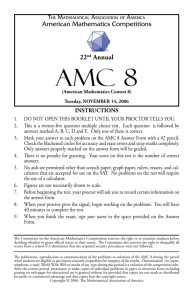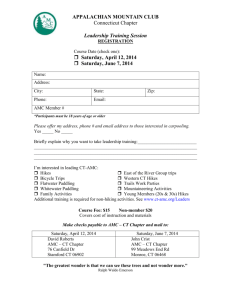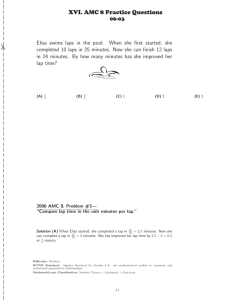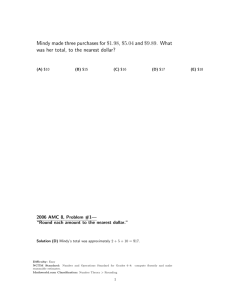AMC 8
advertisement
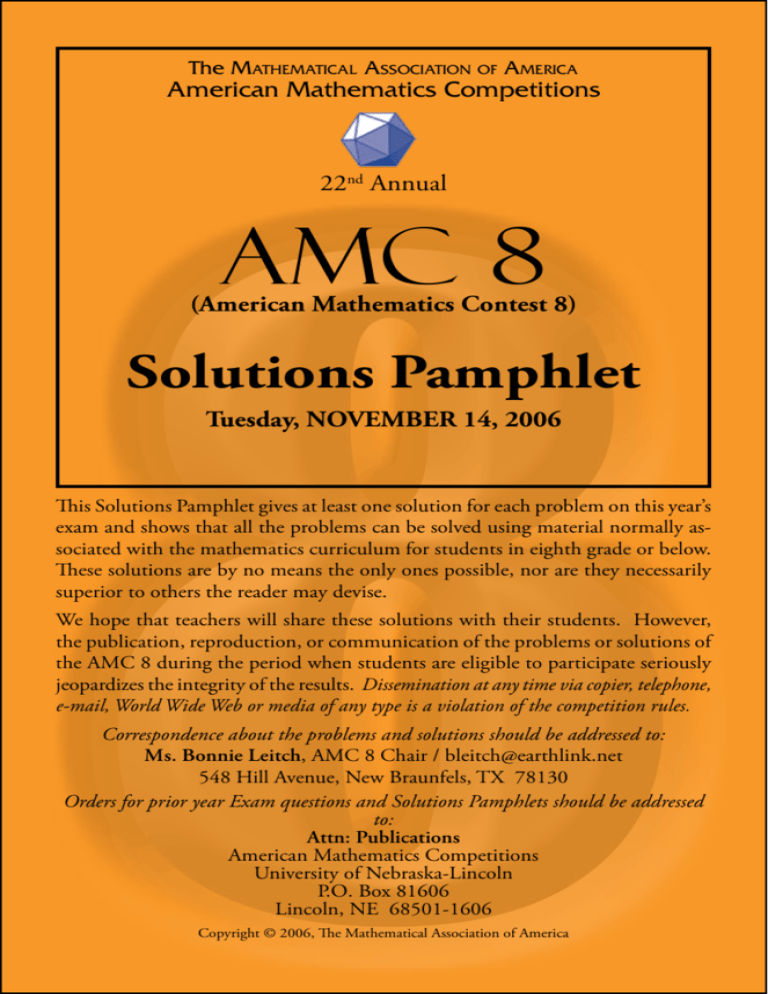
The Mathematical Association of America American Mathematics Competitions 22nd Annual AMC 8 (American Mathematics Contest 8) Solutions Pamphlet Tuesday, NOVEMBER 14, 2006 This Solutions Pamphlet gives at least one solution for each problem on this year’s exam and shows that all the problems can be solved using material normally associated with the mathematics curriculum for students in eighth grade or below. These solutions are by no means the only ones possible, nor are they necessarily superior to others the reader may devise. We hope that teachers will share these solutions with their students. However, the publication, reproduction, or communication of the problems or solutions of the AMC 8 during the period when students are eligible to participate seriously jeopardizes the integrity of the results. Dissemination at any time via copier, telephone, e-mail, World Wide Web or media of any type is a violation of the competition rules. Correspondence about the problems and solutions should be addressed to: Ms. Bonnie Leitch, AMC 8 Chair / bleitch@earthlink.net 548 Hill Avenue, New Braunfels, TX 78130 Orders for prior year Exam questions and Solutions Pamphlets should be addressed to: Attn: Publications American Mathematics Competitions University of Nebraska-Lincoln P.O. Box 81606 Lincoln, NE 68501-1606 Copyright © 2006, The Mathematical Association of America Solutions AMC 8 2006 2 1. (D) Mindy’s total was approximately 2 + 5 + 10 = $17. 2. (C) On the AMC 8 a student’s score is the number of problems answered correctly. So Billy’s score is 13. Because there is no penalty for guessing, if he wants to increase his score, he probably should fill in the last five answers. 3. (A) When Elisa started, she completed a lap in 25 10 = 2.5 minutes. Now she can 24 complete a lap in 12 = 2 minutes. She has improved her lap time by 2.5−2 = 0.5 or 21 minute. 4. (B) Ignore the number of complete revolutions because they do not affect direction. One-fourth of the distance around the circle clockwise from west is north. Three-fourths of the distance counterclockwise around the circle from north is east. Chenille’s spinner points east. 5. (D) Divide the larger square into 8 congruent triangles, as shown, 4 of which make up the smaller square. A D B C The area of the smaller square is 48 or 12 of the area of the larger square, so the area of the smaller square is equal to 30. Solutions AMC 8 2006 3 6. (C) 4 2 2 1 1 4 4 2 The perimeter is 4 + 2 + 1 + 4 + 2 + 4 + 1 + 2 = 20 inches. OR Each rectangle has perimeter = 2l + 2w = 2(4) + 2(2) = 8 + 4 = 12 inches. When the two rectangles are positioned to form the T, a two-inch segment of each rectangle is inside the T and is not on the perimeter of the T. So the perimeter of the T is 2(12) − 2(2) = 24 − 4 = 20 inches. 7. (B) Because circumference C = 2πr and circle Y has circumference 8π, its 2 radius is 8π 2π = 4. Because area A = πr and circle Z has area 9π, its radius is √ 9 = 3. Ordering the radii gives 3 < π < 4, so the circles in ascending order of radii length are Z, X and Y . 8. (E) Because 200 − 96 = 104 of those surveyed were male, 104 − 26 = 78 of those surveyed are male listeners. Male Female Total Listen 78 58 136 Don’t Listen 26 38 64 Total 104 96 200 The percentage of males surveyed who listen to KAMC is 78 104 × 100% = 75%. Solutions AMC 8 2006 4 9. (C) Note that in each fraction, the numerator is the same as the denominator 3 4 5 2006 in the next fraction, so they divide. The product of ¢ × ¢ × ¢ × . . . × » »= » 2 ¢3 ¢4 2005 2006 = 1003. 2 10. (A) When the area of a rectangle is 12 square units and the sides are integers, the factors of 12 are the possible lengths of the sides. In point form, the side lengths could be (1, 12), (2, 6), (3, 4), (4, 3), (6, 2) and (12, 1). Only graph A fits these points. 11. (C) The sum of the digits of a two-digit number is at most 9 + 9 = 18. This means the only possible perfect square sums are 1, 4, 9 and 16. Each square has the following two-digit possibilities: 1 : 10 4 : 40, 31, 22, 13 9 : 90, 81, 72, 63, 54, 45, 36, 27, 18 16 : 97, 88, 79 There are 17 two-digit numbers in all. 12. (D) Note that 70% of 10 is 7, 80% of 20 is 16 and 90% of 30 is 27. Antonette answers 7 + 16 + 27 = 50 problems correctly out of 60 problems in all. Her overall score is 50 60 or 83.3%. 13. (D) Between 8:30 and 9:00 AM Cassie travels 6 miles. At 9:00 Cassie and Brian are only 56 miles apart. After 9:00, because they are both biking towards each other, the distance between them decreases at the rate of 12 + 16 = 28 miles per hour. At that rate, it will take them 56 28 = 2 hours to meet. So they will meet at 11:00 AM. 14. (B) Bob takes 45 − 30 = 15 more seconds per page than Chandra. So the difference in their total reading times is 760 · 15 = 11,400 seconds. Bob will spend 11,400 more seconds reading than Chandra. Solutions AMC 8 2006 5 15. (C) The ratio of time it takes Bob to read a page to the time it takes Chandra to read a page is 45:30 or 3:2, so Bob should read 23 of the number of pages that Chandra reads. Divide the book into 5 parts, each with 760 5 = 152 pages. Chandra will read the first 3 · 152 = 456 pages, while Bob reads the last 2 · 152 = 304 pages. OR If Chandra reads x pages, she will read for 30x seconds. Bob has to read 760 − x pages, and this takes him 45(760 − x) seconds. Because Chandra and Bob read the same amount of time, 30x = 45(760 − x). Solving for x, 30x = 45 · 760 − 45x, 75x = 45 · 760, 45·760 = 456. x= 75 So Chandra will read the first 456 pages. 16. (E) The least common multiple of 20, 45 and 30 is 22 · 32 · 5 = 180. Using the 180 LCM, in 180 seconds Alice reads 180 20 = 9 pages, Chandra reads 30 = 6 pages 180 and Bob reads 45 = 4 pages. Together they read a total of 19 pages in 180 seconds. The total number of seconds each reads is 760 19 · 180 = 7200. 17. (B) Because the sum of a number from spinner Q and a number from spinner R is always odd, the sum of the numbers on the three spinners will be odd exactly when the number from spinner P is even. Because 2 is the only even number on spinner P, the probability of getting an odd sum is 13 . 18. (D) Four black and five white squares are visible on each of the six faces of the cube. So 95 of the surface will be white. 19. (D) Because triangles ABD and ECD are congruent and triangle ABC is isosceles, EC = AB = BC = 11. That means BD = 11 2 or 5.5. Solutions AMC 8 2006 6 20. (C) Each of the six players played 5 games, and each game involved two players. So there were 6·5 2 = 15 games. Helen, Ines, Janet, Kendra and Lara won a total of 4 + 3 + 2 + 2 + 2 = 13 games, so Monica won 15 − 13 = 2 games. 21. (A) Using the volume formula lwh = V , the volume of water in the aquarium is 100 × 40 × 37 = 148, 000 cm3 . When the rock is put in, the water and the rock will occupy a box-shaped region with volume 148, 000 + 1000 = 149, 000 cm3 . The volume of the water and the rock is 100 × 40 × h, where h is the new height of the water. The new volume = 4000h = 149, 000 cm3 , so the new height is 149000 h= = 37.25 cm. 4000 After adding the rock, the water rises 37.25 − 37 = 0.25 cm. OR Because the shape of the rock is irrelevant, we may assume that the rock is shaped like a rectangular box with base measuring 100 cm × 40 cm and height h 1000 cm. Using the volume formula, 100 × 40 × h = 1000, so h = 100×40 = 0.25 cm. When the rock is put into the aquarium, the water level will rise by 0.25 cm. 22. (D) If the lower cells contain A, B and C, then the second row will contain A + B and B + C, and the top cell will contain A + 2B + C. To obtain the smallest sum, place 1 in the center cell and 2 and 3 in the outer ones. The top number will be 7. For the largest sum, place 9 in the center cell and 7 and 8 in the outer ones. This top number will be 33. The difference is 33 − 7 = 26. 23. (A) The counting numbers that leave a remainder of 4 when divided by 6 are 4, 10, 16, 22, 28, 34, . . .. The counting numbers that leave a remainder of 3 when divided by 5 are 3, 8, 13, 18, 23, 28, 33, . . .. So 28 is the smallest possible number of coins that meets both conditions. Because 4 × 7 = 28, there are no coins left when they are divided among seven people. OR If there were two more coins in the box, the number of coins would be divisible by both 6 and 5. The smallest number that is divisible by 6 and 5 is 30, so the smallest possible number of coins in the box is 28. 24. (A) We can decompose CDCD into CD × 100 + CD = CD(101). That means that A = 1 and B = 0. The sum is 1 + 0 = 1. 25. (B) There are one odd and two even numbers showing. Because all primes other than 2 are odd and the sum of an even number and an odd number is odd, the common sum must be odd. That means 2 must be opposite 59 and the common sum is 2 + 59 = 61. The other two hidden numbers are 61 − 44 = 17 and 61 − 38 = 23. The average of 2, 17 and 23 is 2+17+23 = 42 3 3 = 14. The American Mathematics Competitions are Sponsored by The Mathematical Association of America The Akamai Foundation Contributors American Mathematical Association of Two Year Colleges American Mathematical Society American Society of Pension Actuaries American Statistical Association Art of Problem Solving Canada/USA Mathcamp Canada/USA Mathpath Casualty Actuarial Society Clay Mathematics Institute Consortium for Mathematics & its Applications Institute for Operations Research and the Management Sciences L. G. Balfour Company Mu Alpha Theta National Council of Teachers of Mathematics National Assessment & Testing Pedagoguery Software Inc. Pi Mu Epsilon Society of Actuaries U.S.A. Math Talent Search W. H. Freeman and Company Wolfram Research Inc.

